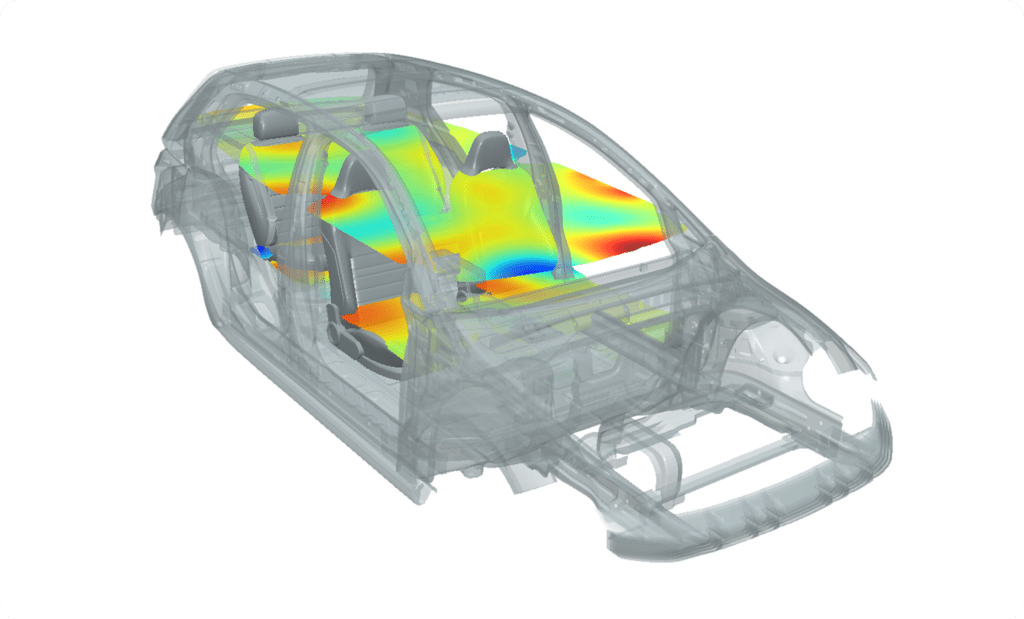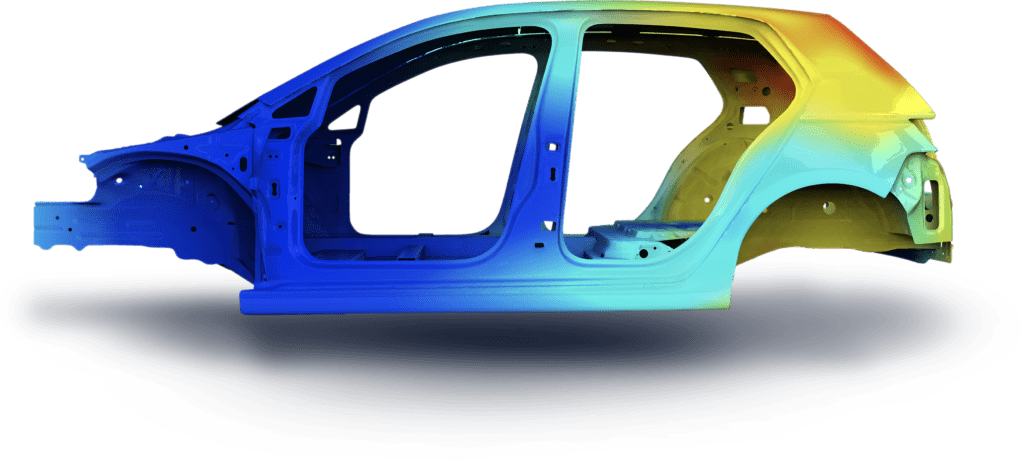In order to study the interaction of structural vibration with the adjacent fluid, it is necessary to model the acoustic behavior of the involved structural components. This can be achieved with the rich material library of Actran, that includes the conventional material for acoustic or visco-elastic media, porous or incompressible media, composite materials or active components like piezo-electrics. If you prefer, a modal basis of the structure may also be imported from most structural FEA codes.
With the ability to simulate realistic modeling boundary conditions by combining dynamic, kinematic and acoustic constraints, as well as physical excitations like diffuse sound field and turbulent boundary layer, you can obtain accurate representation of the acoustic performance of your designs. In addition, you also have the ability to combine this capability with Actran AeroAcoustics to giving you the ability to model complex aero-vibro-acoustic problems.

Sample applications:
- Automotive: Noise related problems from powertrains, intakes, exhausts, passenger compartment, trim, seats, hoses, tires, windows and windshields, audio, HVAC.
- Aerospace and Space: Sound transmission through cockpit and fuselage, noise propagation in air distribution system, response to TBL excitation, random dynamic response of rocket payload at take-off.
- Consumer goods: Telephones, headsets, loudspeakers, hearing aid devices, disk drives, washing machines, refrigerators, cameras.
- Defense: Underwater acoustics, sonars.
Actran SEA: Efficient mid- and high- vibro-acoustic CAE module
The Statistical Energy Analysis approach offers an efficient solution to study noise and vibration propagation inside large systems at mid- and high-frequencies. The global system is reduced to a set of coupled subsystems and energy balance between them is computed.
Building a SEA model with classical approaches usually requires an access to experimental data or analytical expressions limiting the range of geometrical objects that could be handled. With Actran SEA module and its Virtual SEA approach, CAE engineers can use their existing Finite Elements vibro-acoustic models (mode shape and eigen values) to create a SEA model. Based on automatic or user-defined subsystems definition, SEA parameters are efficiently extracted from the Finite Elements model to perform sound and vibration analysis at mid- and high frequencies together with transfer path analysis regardless the availability of SEA expertise or experimental-based information. Combined with a unique frequency extrapolation method, the Actran SEA module offers the possibility to extend the frequency range validity of existing vibro-acoustic finite elements models to high frequency analysis.

Complete system of vibro-acoustic performances can be predicted thanks to realistic physical excitation including spatially and frequency dependent distributed load and pressure as well as diffuse sound field and turbulent boundary layer.
Sample applications:
- Automotive: vibro-acoustic response and transfer path analysis of complete vehicle submitted to structural and acoustical loads.
- Aerospace and Space: Vibration response and transfer path analysis of fuselage submitted to turbulent boundary layer or diffuse sound field excitations. Rocket payload integrity analysis at take-off.
- Shipbuilding: Onboard noise prediction due to machinery noise and flow induced vibrations.
- Railway: Interior acoustic comfort prediction of train coach.
- Off-road Vehicles: Cabin noise comfort prediction.
Actran for Trimmed Body: Advanced vibro-acoustic analysis combining Actran and MSC Nastran
Actran for Trimmed Body is a powerful tool for modeling and analyzing complex vibro-acoustic systems such as trim components. Such components are usually made of materials with high damping and strong acoustic absorption characteristics; as such they have a significant influence on the overall vibro-acoustic behavior of the structure.
Actran for Trimmed Body provides CAE engineers advanced features for mixing the best of both worlds: Actran physical model and Nastran modal model. Three types of combined models may be created:
- Actran for Trimmed Body is able to merge a set of Actran models of individual trim components with a Nastran body-in-white model in order to create a fully trimmed body vibro-acoustic model
- An Actran model may be set in its real-life working environment by connecting it to an existing Nastran model (e.g. a detailed Actran model of a layered windshield may be connected to a Nastran model of the vehicle body)
- A Nastran model may be enriched by including a reduced Actran model of a specific component. The Actran component is defined as a DMIG data block in the Nastran deck

Sample applications:
- Acoustic transmission through components in real-life mounting conditions
- Trimmed body modeling using a combination of Actran detailed models in physical coordinates and a Nastran body-in-white modal model

